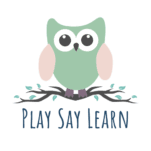Best Books for Speech Therapy:
Ultimate Guide to Using Books to Develop Speech and Language Skills in Babies and Toddlers
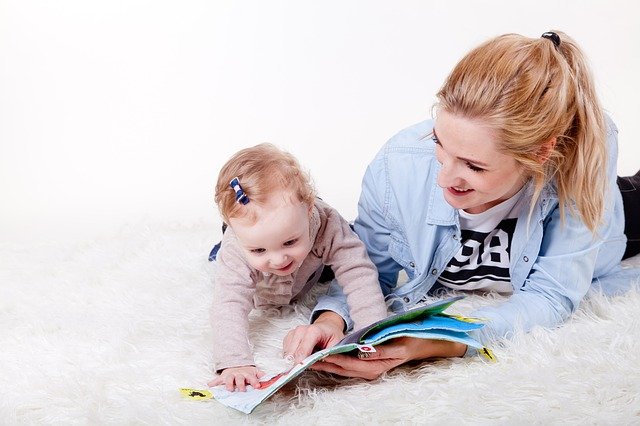

Using books in therapy is probably my favorite way to work on speech and language with young children. I must admit, I have a serious addiction to children’s books! I am going to share with you some of my all time favorite children’s books and how to use them to facilitate speech and language development in babies, toddlers and preschool children.
“Joint book sharing,” as I refer to it, is more than just turning the pages and reading a book to your child. It is a fun and engaging way to interact and connect with your little one. It involves looking at a book together and sharing attention to the actions and objects in the book, without necessarily having to “read” in the strict sense of the word. The goal is for your child to attend with you, have fun, and along the way you can work on the skills that foster communication development. These skills may include learning to establish joint attention (looking at and focusing attention toward the same object together – very important for communication!) identifying and labeling objects and actions, learning a rhyme, song or social routine, and developing early literacy skills.
So what are the best books for babies and toddlers? Here are some of my favorites along with tips and suggestions that will help to make joint book sharing a fun activity your child will want to come back to again and again!
Making Book Sharing Interactive and Engaging
A great first tip for reading books with babies and toddlers is to choose books that are interactive. Examples include lift-the-flap books, sensory books (touch and feel books), and pop-up books. You can also create some easy activities that go along with your books such as matching animals to pictures, acting out actions, or imitating animals or people with sounds or movement. I remember my son’s first interactive book given to us as a gift, Pat the Bunny, by Dorothy Kunhardt. It has sweet, old fashioned pictures with interactive components such as lifting the flaps and feeling dad’s rough and “scratchy” beard. This was a favorite first book for my own kids.
When it comes to words written on the pages, don’t always feel you need to read the actual words out loud to your child. You can shorten the story or just talk about pictures and actions in the story. You will often get more out of a book by not reading it word for word. It is ok to deviate from the script and create your own around the pictures and story to match your child’s current language level. The goal is to improve joint attention and foster engagement; foundational skills for speech and language development.
While looking at the book together, feel free to use different voices and intonation (vary your voice and volume from soft to loud, low to high pitch), or animal and environmental sounds (moo, woof, wee!, beep-beep, vroom!). Using rhythm and intonation along with patterns and repetition that occur in nursery rhyme books and those with lots of play/environmental sounds (ex. “wee!” and “vroom!”) are wonderful ways to build the foundation for developing communication skills. In addition, think about your own energy level. When your energy level is high, you will be more engaging to your child.
Using singing is another great strategy to encourage your child to vocalize and join in. Kids love to sing along and this is a great early language development technique. Once your child has heard the song many times, you can sing the first part and then pause, allowing her to fill in a word or two. Repetition is a key strategy for fostering language development and important for developing early literacy skills as well. I encourage parents to “read” the same book over and over again with their children. Kids love and crave routine so it’s great to find books to incorporate into everyday routines such as bedtime that can be repeated each night.
Sit together and hold your toddler in your lap to read books. For toddlers with sensory issues, close body contact and firm touch is regulating and calming. Holding your child will also help foster social and emotional connection. Before we can even begin to target sounds and words in therapy, we have to establish this connection with a child. If your toddler doesn’t want to be held, sit across from him and hold the book so he can see the pictures. If you sit across from him, he will be more likely to stay with you, maintain attention and connect with you.


In order for joint book reading to be a shared activity, the child needs to attend to you and what you are saying about the pictures and story. If the child is not tuned in to what you are saying, this is not a language learning activity. If we want to use books to help a child learn language, the adult has to be included in the reading activity. You have to help the child learn to link meaning with the pictures in the book.
So now that we have covered some of the whys and hows of joint book sharing, here are my recommended books for babies and toddlers. I’m also going to share with you some of the ways I use these books during therapy sessions. You should tailor the book to the child and the specific skill you’re working toward. You can of course use the same books for multiple purposes and change how you use the book as the child’s language skills mature.
You can find the link to purchase the books mentioned here at the bottom of this post (I am NOT an Amazon affiliate. This is simply my curated list of suggested books for babies and toddlers.).
Early Books for Babies and Toddlers
Picture books that use actual photos with only one or two pictures per page are a really good place to start. Roger Priddy has authored many simple picture books that are great. Because these books contain photographs instead of drawings, the pictures are more like real life and more easily recognizable to a baby or toddler.
Part of his “Bright Baby” series are First Words, Animals, and Colors. One way to use this kind of book of real photographs is to teach early picture identification. First, you will need to teach or model the words. Point to the picture as you say its name repeatedly. In order to learn the meaning of words and be able to point to and identify pictures, a child has to hear the word many times. Repetition is the key to language learning


Sometimes, late talking toddlers don’t understand the meaning of words. A two year old should be able to point to several familiar pictures on request. If she cannot to this, she may not understand words as well as she should for her age. Quite often, parents mistakenly believe their child understands everything when in reality there is a receptive language problem, and this is directly related to the language delay.
One way I use simple picture books is to teach a child to follow directions. I use books such as Baby Faces, by Dorling Kindersley. Babies make cute little faces in this book. You can teach very simple actions such as kiss the baby or pat the baby.
Perhaps you have a child who likes books but doesn’t have great play skills yet. Maybe the child has difficulty following verbal directions. Using this type of book, you can work on receptive language and teach a child to imitate actions, an important developmental step in learning how to talk.
When using this type of book, I keep my language very simple. Try to say fewer words so you don’t overstimulate a child and lose him. Name the pictures using simple language. Model the action you want him to complete. I might try to imitate the faces baby is making and encourage the child to try. For example, with the baby book, I might say “Look! Baby! See baby? Stick out tongue! You try!” Or perhaps, “Kiss baby!” Aw, so cute,” or “Baby is crying, kiss baby.”
I would pretend to kiss the baby on the page by bringing my face toward the book. Model that same action several times as you’re saying “Kiss!” Hopefully the child will catch on and try to kiss the baby. If needed you can help by bringing the book in a little closer to the child’s face to cue him. By keeping it lighthearted and fun with lots of smiles and animation in your face, he is likely to join in eventually and copy you.
I also use “Pat the baby, ” taking the child’s hand and helping him pat the baby. I’ve also used the word “nice” as we pat or stroke gently over and over again while repeating the word.
There are other similar books I’ve used depending on the child’s interests including Animals, Puppies and Trucks, also from the Bright Baby series. You can use this concept with other kinds of books as well. If you’re using a book that has a door or a flap you are going to look under (For example the Where’s Spot book, which we will discuss later in this post), pretend to knock on the door. If you see a flower or something that smells, pretend to sniff it. Imitating actions is an important initial goal for late talking toddlers. Using books, you can help a child learn to imitate.
When it comes to books that have batteries and make sounds, I typically don’t like them! A child will often perseverate on pushing the buttons to hear the noise or watch it light up. We can easily lose a child’s attention, potentially leading to frustration and meltdowns. Typically, if a book or toy has a battery and makes noise, I remove the battery to eliminate the distractions. Simple!
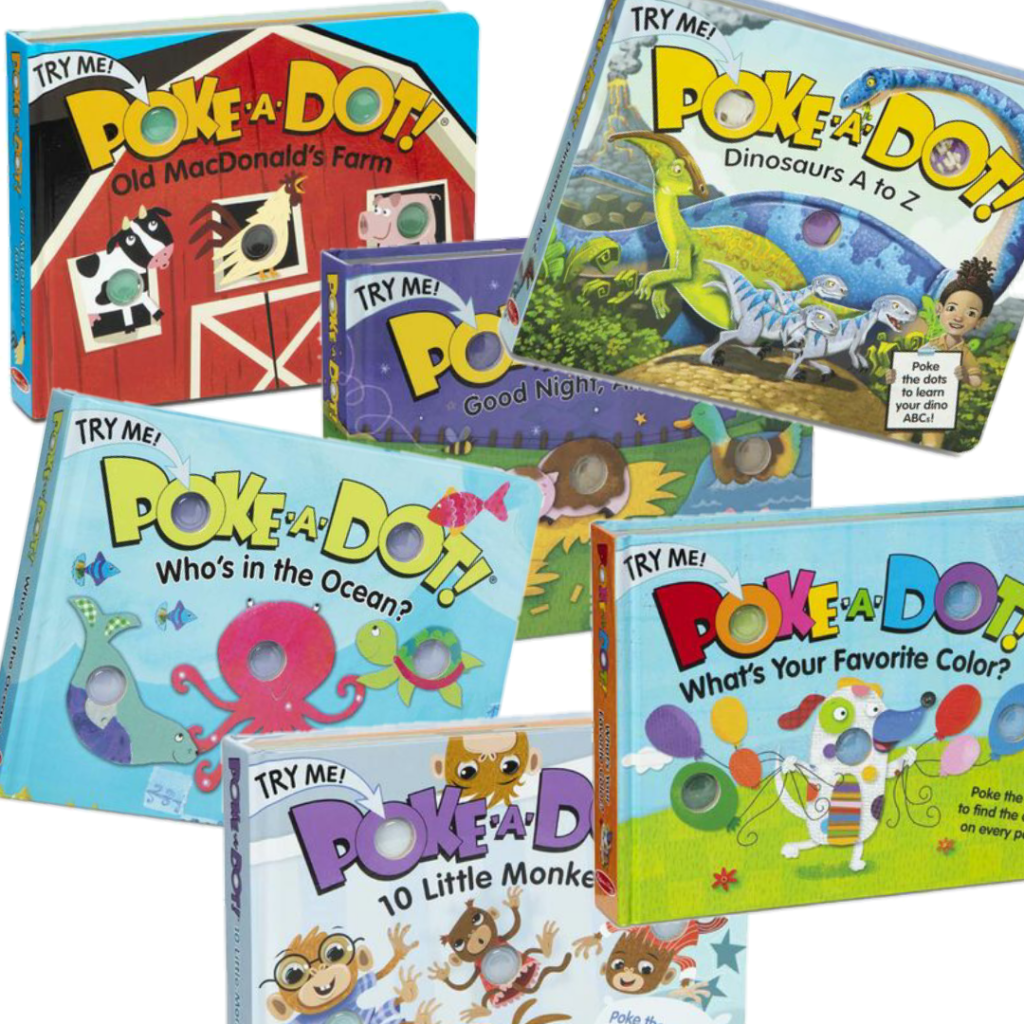

Poke-A-Dot books by Melissa and Doug are a series of interactive board books where children poke the bubble dots on the page and make them click and pop. No electronics here! In addition to encouraging language development, as a bonus these books are fantastic for encouraging fine motor skill development by promoting index finger isolation. You can count, name animals or say other words such as “pop” as you poke the dots. Children and parents find these books irresistible. Book themes include farm animals, ocean, colors, alphabet and others.
Want a list of all the books mentioned in this post? Click below for your pdf copy!
Books Based on Song, Rhyme or Repetition
Next are books based on songs. If I’m working with a child who loves to sing but is not yet keen on books, I introduce books like these that incorporate song and rhythm to get a child involved and interested.
Find a book based on a song. Sing that song with the child at first without bringing out the book. Once the child is familiar with the song, introduce the book. Point to the pictures as you sing the words just like you did previously.
You will slowly change your singing and use more of a chanting voice, and then a more natural reading voice. After a while, introduce other kinds of books, still using your sing-song voice. Children respond well to this strategy. If your child is sensitive to singing or doesn’t like it, you can try chanting the words instead. Chanting is often a great way to help a child get used to singing and eventually even like it.
Ten Little Monkeys Jumping On The Bed or Ten Little Monkeys Swinging In The Tree are two books with corresponding songs. Some other songs/finger plays are “If You’re Happy and You Know It Clap Your Hands, Head-Shoulders-Knees and Toes, Twinkle Twinkle Little Star, The Itsy Bitsy Spider, Open Shut Them” and “This Little Piggy.” “Old MacDonald” is another great song and book for toddlers and preschoolers for eliciting animal names/sounds as well as vowels “E-I-O!” “The Wheels On The Bus” is another favorite for toddlers, and if you’re looking for a different twist on the story that includes animals, try Wheels On The Bus by Jane Cabrera.
Sandra Boynton has authored many bestselling board books. I love them all, especially Blue Hat, Green Hat, Doggies and The Going To Bed Book. Moo, Baa, La La La! is also definitely a favorite. If you have a toddler who can’t sit still for a book, it helps if you give the child something to do with the book to make it more interactive. This makes it more likely that you can hold his attention for the duration of the activity. You can gather small props or objects to match those pictures or themes in the book and the child can match the object and picture. Matching pictures to objects is an important skill to teach.
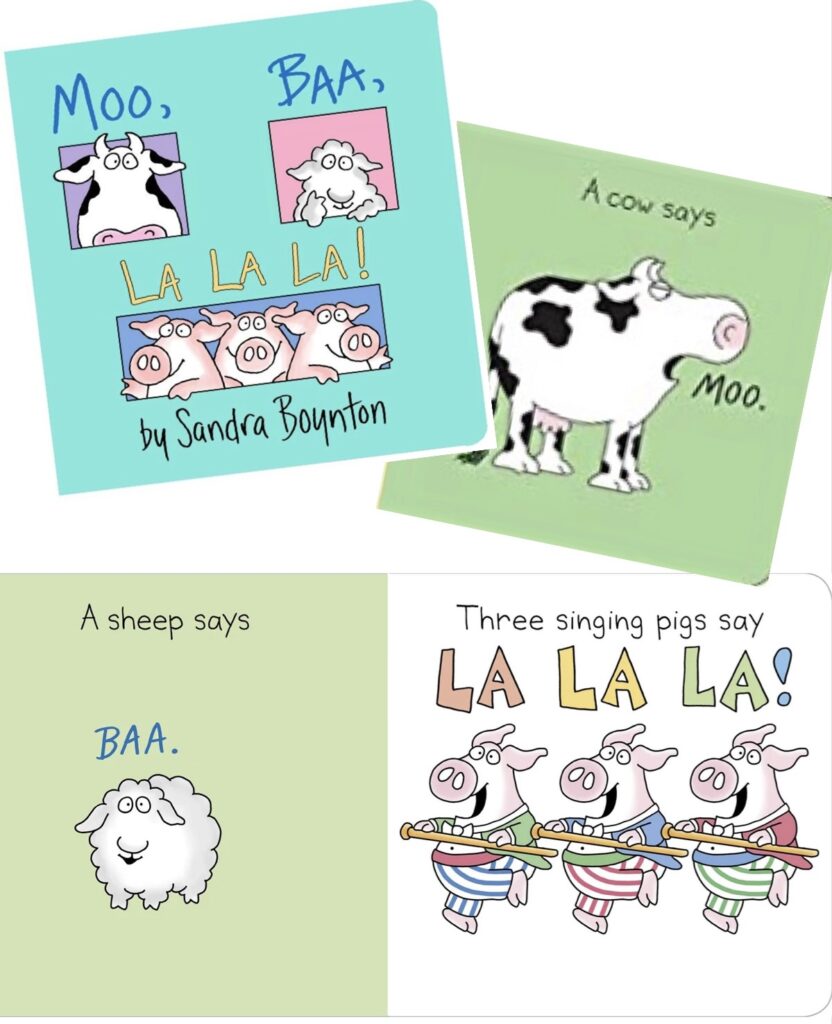

This is a wonderful activity particularly for children who understand some words and simple directions, but aren’t yet pointing to pictures when asked to do so. You will need to gather objects that closely match the pictures in the book. Try to find one to three objects per page, depending on your child’s level. I have used small figures or objects, small stuffed animals, and picture cards for this activity with success. I have also used magnets that match items in the book and set them out on a baking sheet for the child to select.
Keep a container or baggie nearby for the child to put the object in after she has chosen it. This keeps the focus of the activity on the book rather than the child collecting items and running away with them. Start by finding just one object that the child is familiar with and build to finding more as the child becomes better at matching and participating in this activity.
Once you have gathered the objects you plan to use with the book, choose 1-3 that you will set out in front of your child. Point to the picture and say “Find this one. Where’s the …?” To get your child more involved and hold her attention, have her turn the pages. And oh yes, the reason I love board books for babies and toddlers is because they can’t tear the pages!
This type of activity keeps a child involved and teaches several skills at once. In addition to teaching the skill of matching, this will help a child who is still learning to understand the symbolism of pictures; that the picture represents the object.
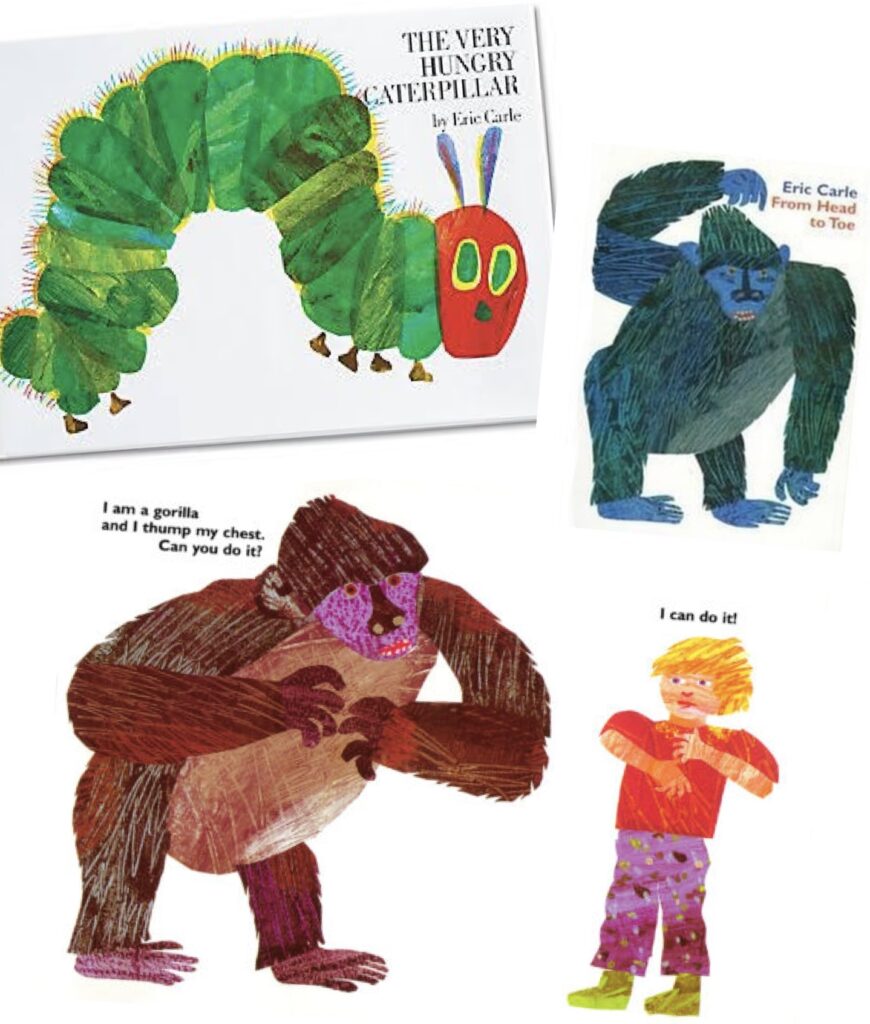

You can also adapt other books using this same method. The Very Hungry Caterpillar, by Eric Carle, is a fantastic one to try because you can use it to teach so many concepts. For instance, you can use a stuffed caterpillar and some pretend food, or the caterpillar can be photocopied from the book and laminated along with the food pictures. Make the caterpillar “eat” the food for another fun extension of this book.
Little Blue Truck by Alice Scherle and Eric Carle’s Head to Toe, are great books that use repetition in the lines. Because they are repetitive there is a verbal routine that can help the child learn and recall the language more easily. The line in Head to Toe is “Can you do it? I can do it!” After he has heard you read it a few times, encourage your child to yell the lines out loud with you. The yelling often entices reluctant children and they are more willing to actually act out the story with gestures and motions. I have been able to get children to say new words using this technique as they get lost in the yelling and fun. When you use a book in this way, you are addressing two important skills that will support language development: teaching a child to imitate body movements and establishing verbal routines.
And now, we have the most famous speech therapy book that every therapist knows by heart: Brown Bear, Brown Bear, What Do You See? by Eric Carle. I use it almost daily in my therapy sessions. Here are some ways I use this book.


There are several versions of this book from large to small to board book style. My favorite is the one pictured here that has an interactive slider feature that children can open and close to reveal the animals (they love doing this!). Children can also get some great practice with learning to point using this book because they learn to isolate their index finger to move the slider.
One of my favorite things to do with Brown Bear is teaching play sounds. Many toddlers begin speech therapy with the ability to make some animal sounds but aren’t ready to say single words. In this case, focus on the vocal play stage where you practice animal sounds since you know this is where the child can be successful.
Another way I use Brown Bear is to teach the word “me.” The word “me” is the last word of every page so it’s repetitive and thus, a verbal routine. A child begins to expect that word and if you set it up just right, he will often blurt it out before he even knows he’s talking. I also use a big gesture, bringing my palm to my chest when I say “me” to help a child use this gesture himself if he cannot yet say the word.
Once a child has mastered the word “me,” I try to elicit “see” using the same strategy of reading the book until a child becomes familiar with the word and anticipates it; “Brown bear, brown bear, what do you… .” I use big facial expressions, body language, and I pace my voice so that it entices him to talk. Add the expectant waiting or pausing at the right times, showing anticipation in your face, and hopefully he can learn to fill in the word soon enough.
Polar Bear, Polar Bear, What Do You Hear? is similar to Brown Bear, also by Eric Carle. You can target the same types of goals and use the same strategies while changing up the book. Children love this one as well. A book similar in the repetitive rhyme genre is I Went Walking, by Sue Williams. We have fun repeating the lines or doing a fill in the blank; “I went walking, what did you see? I saw a …. looking at ME!”
What would a book list be without the classic night time favorite, Goodnight Moon, by Margaret Wise Brown. The words are poetic and the illustrations soothing, making it the perfect bedtime story. Say goodnight to all of the familiar things in the softly lit rooms. Together, you can find the bears, socks, clocks, and practice saying “night-night” to each one, or waving, depending on your child’s current level of development. The Runaway Bunny is another classic by this same author. A little bunny keeps running away from his mother, but mother finds him every time. With reassuring words and loving pictures, this is a must read for babies and toddlers.
Big Red Barn is another sweet book by Margaret Wise Brown. The simple, rhythmic text tells about a day on the farm and a family of animals. Follow along with the animals from morning to night in this tranquil bedtime classic.
More Books for Babies and Toddlers
Wait, I can’t end the list yet! Here are some more of the best books to use with young children to support speech and language development:
Peek-a-Moo and Peek-a-Zoo by Marie Torres Cimarusti – These are two very cute books that are “lift the flap” where you can repeat on each page “peek-a…,” lift the flap revealing a different animal, and say the sound it makes such as “moo!” It is very simple and repetitive, which allows your child to learn the familiar line and then fill in the ending. Peek-a-Who by Nina Laden, is another book with a similar theme, but is smaller and sold in a board book style which is great for toddlers who like to rip pages!
Dear Zoo by Rod Campbell is a classic and such a fun book. This repetitive, interactive flap book brings the zoo to your home. Large crates arrive but only to be sent back to the zoo because the animals are too tall, naughty, etc. With fun, simple art and great descriptives, Dear Zoo will help keep children engaged. This is a must have for all toddler book collections.
One Hungry Monster by Susan Heyboer O’Keefe, is another repetitive rhyming board book. Adorable (not scary!) monsters invade a little boy’s home in an attempt to get some food. It begins, “One hungry monster underneath my bed, moaning and groaning and begging to be fed!” Counting from one to ten with adorable rhymes and pictures, the boy feeds the monsters and they make mischief and mess, until he’s had enough. The repetition and rhyme promote language comprehension and recall, all while having a fun time reading together. My own kids loved this book!
Open the Barn Door, by Christopher Santoro is another cute board book for your toddler library. This repetitive lift-the-flap book is great to work on making animal sounds, answering simple who-questions, naming animals and talking about what animals are doing or where they live.
If You See a Kitten by John Butler is a sweet animal book. “If you see a cuddly kitten, say ahhh!” If you have a young child who is working on vocalizing, using simple sounds, vowels or imitation, this book is perfect. The repetition and prediction make this a fabulous book for working on those skills. The art is adorable and children love the animals.
Who Will Tuck Me In Tonight by Carol Roth is a bedtime favorite. Poor little lamb cannot find his mom to tuck him in at night. All the farm animals try to help but no one can do it like mom. You can have fun using different voices while narrating.
My Truck is Stuck by Kevin Lewis is a must have for the truck, car, or bus lover. This book has great rhyming and repetition and wonderful sounds. Get ready for lots of BEEPS, HONKS, and HEEEELPS! It’s fun to act this book out with small vehicles.
“Usborne Touchy-Feely Books” is a fun series of That’s Not My … books. The art is simple and cute and the touch-and-feel sensory components help keep young children engaged. The princess book reads, “That’s not my princess…her tiara is too bumpy.” Feel the bumpy tiara in the picture as you read. Look for That’s Not My… Tractor, Goat, Fairy, Unicorn, etc. There are so many of these to choose from.
Time for Bed, by Mem Fox is a sweet read that is a nighttime staple. Rhyming, rhythmic, repetitive and predictable, it has all the ingredients to help your child learn new words and recall them. Have your child fill in the blanks as you read aloud and pause. You will love this book and its beautiful illustrations. “It’s time for bed, little mouse, little mouse. Darkness is falling all over the house.” This favorite is sure to help set the mood for bedtime and lull your toddler to sleep.
Itsy Bitsy Spider, by Iza Trapani is a different twist on a classic for toddlers. The itsy bitsy spider climbs up the kitchen wall and “swoosh” goes the fan and makes the spider fall. This cute rendition of itsy bitsy spider will expand your thinking from the traditional song. Spider meets a fan, cat, mouse, rocking chair and a maple tree. It is great for working on singing along, labeling and vocabulary. With rhyming and the ability to sing and do motions, this will keep your child engaged.
All Better, by Henning Lohein – What preschooler doesn’t love band-aids? In this sweet interactive boo-boo book, kids get to help animals and make them feel “all better” by putting bandaids on their boo-boos. The band-aids that come with the book have corresponding animal pictures on them to match the characters in the story. Have fun choosing the wrong band-aid for the animals and make a silly game of it.
Where is Maisy? by Lucy Cousins – The Maisy series of books consists of fun stories with familiar topics for toddlers. Maisy is hiding in this particular book. Build vocabulary by talking about all the things in her house and practice early prepositions such as in, on, and under. Other themes include holidays, sports, travel, and around the town.
Oh Dear, by Rod Campbell – A little boy has to look in all the animal homes to find some eggs for breakfast. Each page has a flap to open and you can say “no eggs!” The repetition is great for learning. Finally at the end, the boy finds the eggs in the henhouse. You can yell “eggs” or “found it” with your toddler.
Baby Touch & Feel – Farm by DK, is a touchy-feely book with one animal per page. Clear photographic images make it ideal for babies. Make the animal noises and encourage your child to imitate.
Pop Up Peekaboo Things That Go by DK – This favorite publisher uses high quality photo images. The Peekaboo series has a large flap to fold over on every page. This vehicle book is great for copying sounds like “vroom”; a nice skill to build on if your toddler is not yet talking. When your child is ready, you can build vocabulary and language skills by talking about the cars and trucks, labeling them and talking about their functions.
Ten Little Fingers & Ten Little Toes by Mem Fox – The rhyming and beat are very natural and repetitive in this book. It’s great for fostering listening skills and for working on sentence completion. “Ten little fingers and ten little … .” Encourage your toddler to finish the sentence each time.
Where Is The Green Sheep? also by Mem Fox – Yet another fun book using repetition where toddlers need to find the green sheep. It’s great for toddlers starting to put two words together; “(color) sheep.” You can also practice ‘no’ each time you turn the page and ask if it’s the green sheep.
Where’s Spot, Spot Bakes a Cake, Spot on the Farm, and Spot’s First Easter, by Eric Hill – The “Spot” books are popular and at just the right level for many toddlers with big, bold drawings. I love the Where’s Spot book for asking the question “Is he in/under/on” and then eliciting “no!” The farm book is another favorite where you look for baby animals. It is great for working on all those animal sounds. In the Easter themed book, Spot needs to look for the Easter eggs around the house and garden. You can repeat the line, “egg, got it!” or “no eggs!” In the cake book, Spot makes a birthday cake with his mom. They get everything ready for Dad’s birthday including a card and cake. It’s an easy lift-the-flap Spot book with a basic cooking sequence. It’s also good for talking about places and items around the house.
The Tickle Book – A Little Golden Book. It’s lots of fun anticipating a tickle in this book. You can talk about tickling different people and body parts, as well as tickling with items such as flowers, feathers and hair.
Whose Tail by Sue Tarsky – This book is part of the “Whose Are These” series. In these books, you can see only part of the animal so you have to guess what animal it is by looking at the tail, ears, feet or nose. Cute pictures paired with simple, short phrases on each page such as “still tail, swishing tail,” provide clues so your toddler can guess the animals. It’s great for targeting body parts and verbs.
Toes, Ears, Nose by Karen Katz – Karen Katz has several adorable books for toddlers. Each page has a piece of clothing to lift up to see the body part underneath. It is great for learning to label body parts and clothing.
Counting Kisses, also by Karen Katz – This is another highly repetitive book about bedtime. The familiarity of the theme is great for toddlers as is the repetition of the word “kiss.” If your toddler can’t say this word yet, try making a kissing sound or blowing kisses.
Pants, by Giles Andreae – This is an engaging and fun book. On each page is a different person or animal wearing underpants. You can have fun being silly, since most children get a kick out of talking about underpants!
Busy Park, Campbell Books – In this interactive book, children can look at all the familiar things in the park and move the tabs. The see-saw can go up and down and the gate can close. It’s great for active toddlers who need help maintaining attention a bit longer.
Who Says Moo? by Jane Wolfe – This book is one of a collection of interactive pull-the-lever books for young children. Others include Who Says Neigh, and Who Lives Here. It is great for younger children learning animal noises. Tabs at the side of the book can be pulled to reveal another animal so it is appealing for a more active toddler.
Mrs. Wishy-Washy’s Farm, by Joy Crowley – There are several adorable books in the “Mrs. Wishy-Washy” series, although some of them are harder to come by than others these days. Mrs. Wishy-Washy likes to keep her animals clean, but this time the animals don’t want any part of getting washed in the tub and they make an escape from the farm! Have some fun using props and re-enacting the story using a sensory bin and small plastic animals, washing them just like Mrs. Wishy-Washy does. I like to target verbs such as “run, wash, scrub,” as we read or act out this story together.
Pete the Cat: I Love My White Shoes, by Eric Litwin – For the older toddler and preschool child, this is the first and most famous in this series of “Pete the Cat” books. Pete happily walks along in his new white shoes, but soon enough they change colors as he steps in things along the way. They turn red after stepping in strawberries and turn brown from mud. All the while, Pete goes with the flow and continues to walk and groove in his new shoes. You can pair the word “shoes” with a color such as “red shoes” or other adjectives such as “dirty shoes” or “wet shoes,” if your child is ready to start combining words. Children just love Pete and love to interact with this book.
“Pip & Posy” Books, by Axel Scheffler & Camilla Reid – The Pip and Posy collection of books are beautifully and clearly illustrated. Not too lengthy, they are suitable for preschoolers. In one of the books The Big Balloon, Pip mistakenly lets his beloved balloon go. Posy helps him deal with the problem. These books are a great introduction to simple narratives and problem-solution frameworks. I love this collection of books!
One Mole Digging a Hole, by Julia Donaldson – This is an adorable counting book with clear, simple rhyming pictures. On each page there are different animals doing something in the garden; 3 bears picking pears, 4 foxes filling boxes, etc. I love it for talking about the different animals, objects and actions, as well as counting.
Fox’s Socks, also by Julia Donaldson – Fox is looking for his socks. He finds lots of other clothes while looking, but can’t seem to find socks for his cold feet. Your toddler can look under all the flaps until he finds the socks. Are they under the stairs? In the box? Your child can answer ‘no’ until they are found. This is great for naming clothing items, items around the house and for targeting prepositions.
Happy Birthday by Priddy Books – It’s your birthday today so let’s talk about all the things that will happen – presents, party, food, games and birthday cake. This book has nice clear pictures with touch and feel pieces. Talk about birthday related vocabulary such as cake, birthday, presents and balloons. Finally, sing the birthday song together!
Last but certainly not least, there’s Goodnight Gorilla, by Peggy Rathmann. This was always a favorite in my house as well as a favorite to use in therapy. The adorable gorilla steals the keys from the zookeeper and follows him around the zoo as he closes it down for the evening. The gorilla quietly unlocks the gate for each of the animals and they all make their escape as they follow the zookeeper around secretly. What’s special about this book is that it has no words! Wordless picture books are some of my favorite books to use in therapy and they open up a whole other category of books for us to talk about. Check out my post on Wordless Picture Books for my entire list and to learn all about why these books are a wonderful resource for promoting speech and language skills.
If you are interested in purchasing any of these books on Amazon, the link is here to buy from my curated book list! (I am NOT an affiliate and do not benefit from your purchase in any way.)
While this list is not exhaustive by any means, I think these are some of the best books for babies and toddlers, as well as preschoolers. I hope these ideas are helpful to get you started with using joint book sharing with your baby or toddler to help foster connection, engagement, and speech and language development. Have fun!
